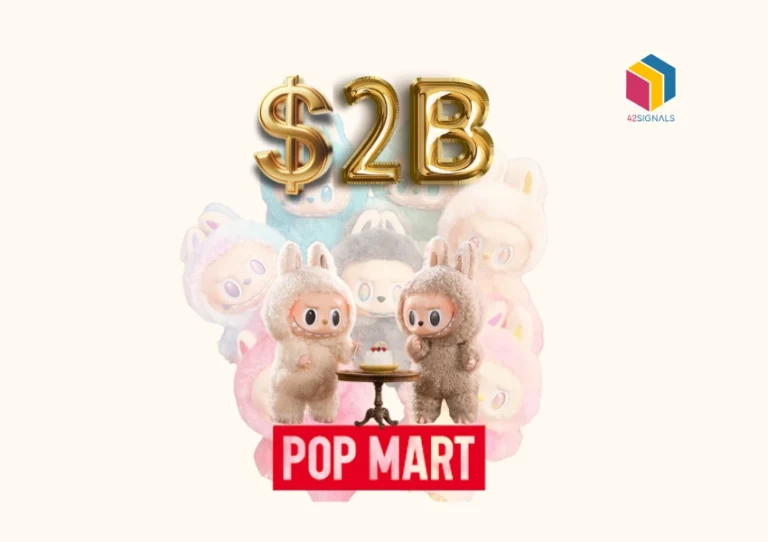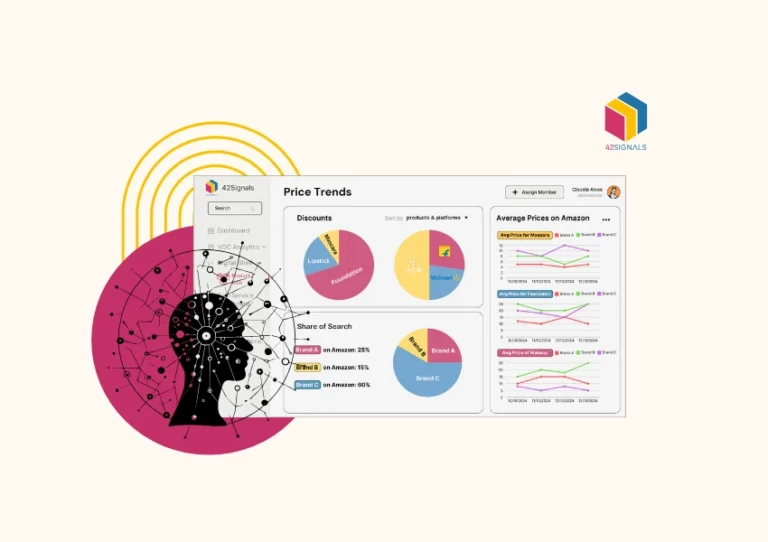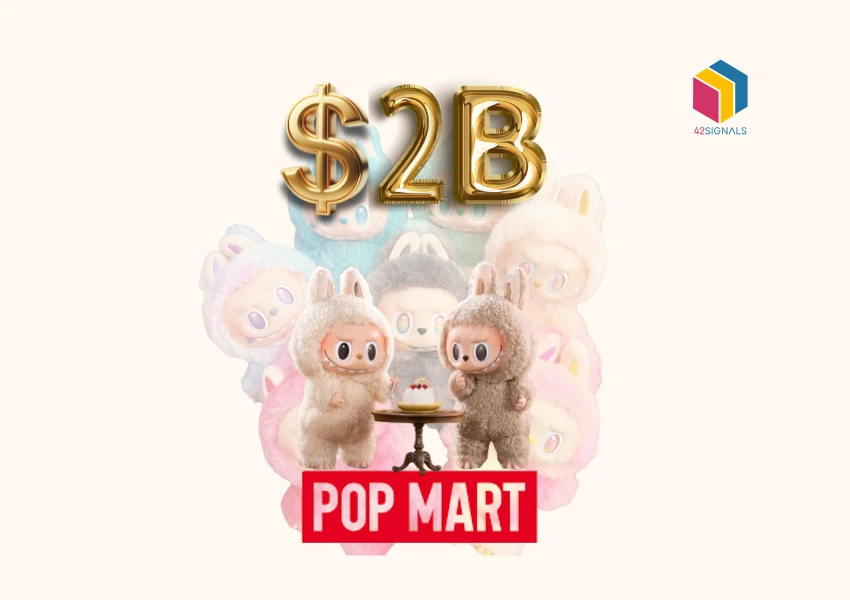The world of e-commerce is highly competitive, especially in a diverse and price-sensitive market like India. Flipkart, one of India’s leading e-commerce platforms, has managed to capture massive attention and establish its annual “Big Billion Days” sale as one of the most anticipated sales events in the country. As e-commerce managers and pricing managers, understanding the intricacies of Flipkart Big Billion Days provides valuable insights into how brands can harness the power of discounts, promotions, and strategic pricing to create impactful e-commerce sales events.
This article dives deep into the marketing and business strategies Flipkart employs during its Big Billion Days sale. The goal is to tear down Flipkart’s approach and explore actionable strategies that other businesses, especially D2C brands, can adapt to elevate their sales and customer engagement, especially during festive promotions.
How did Flipkart Big Billion Days start?
The Flipkart Big Billion Days sale was launched in 2014, marking a turning point in India’s e-commerce landscape. What began as a one-day event has since transformed into a multi-day festival of online retail, offering huge discounts across a wide variety of product categories.
The initial event encountered some logistical and technical issues, but Flipkart’s resilience and ability to learn from mistakes helped the company scale the event into what is now an annual mega-sale, rivaling global events like Amazon’s Great Indian Festival Sale.

Image Source: Dataweave
Why the Big Billion Days Sale is So Important for Flipkart
- Seasonal Influence: The Big Billion Days sale coincides with India’s festive season, particularly around Dussehra and Diwali. This is the time of year when Indian consumers are more inclined to spend on big-ticket items such as electronics, apparel, home appliances, and gifts.
- Revenue Generation: Flipkart generates a substantial portion of its annual revenue during the Big Billion Days. The intense marketing and promotional push ensure that both new and existing customers flock to the platform.
- Brand Awareness and Customer Retention: Big Billion Days isn’t just about sales—it’s about maintaining top-of-mind brand awareness. Flipkart uses this event to increase customer retention and to attract new buyers.

Image Source: Ginger Media
Marketing Strategies That Make Flipkart Big Billion Days a Success
The success of the Flipkart Big Billion Days is the result of a meticulously planned and executed marketing strategy. Flipkart uses a mix of promotions, partnerships, and technology to create a sense of urgency and exclusivity while ensuring a seamless shopping experience for customers. Here’s an in-depth look at the marketing strategies behind Flipkart Big Billion Days.
1. Creating a Sense of Urgency and Scarcity
Why It Works: Flipkart uses a psychological principle called “fear of missing out” (FOMO) to encourage purchases during Big Billion Days. With limited-time deals and flash sales, consumers are motivated to act fast before products go out of stock or prices return to normal.
How Flipkart Executes This Strategy:
- Countdown Timers: One of the most effective ways to build urgency is by using countdown timers. Flipkart prominently displays these timers during the sale, letting customers know how long they have to take advantage of certain discounts.
- Lightning Deals and Flash Sales: Flipkart runs lightning deals that last for a limited time, where prices drop significantly for a short period. This generates high engagement and repeat visits from consumers who don’t want to miss out on the best deals.
- Low Stock Alerts: Products listed with “Only a Few Left” or “Limited Stock Available” signals further enhance the scarcity mindset, compelling customers to buy immediately rather than wait and risk losing the deal.

Image Source: Flipkart Facebook
How Businesses Can Apply This Strategy:
- Implement scarcity tactics like time-limited offers or flash sales.
- Use technology to send real-time notifications or alerts about product availability to keep consumers engaged throughout the sale period.
2. Strategic Use of Discounts and Pricing Intelligence
Why It Works: Discounts are the backbone of the Big Billion Days sale. Flipkart uses advanced e-commerce analytics and pricing intelligence to determine optimal discount percentages that strike a balance between driving volume sales and maintaining profitability.
How Flipkart Executes This Strategy:
- Dynamic Pricing Models: Flipkart uses a sophisticated dynamic pricing system during Big Billion Days, adjusting prices in real-time based on demand, competition, and stock levels. This ensures that they stay competitive while maximizing revenue.
- Pre-Event Price Anchoring: Before the sale kicks off, many products are listed at their full price, helping to create a price anchor. When the sale begins, the steep discounts seem even more appealing to customers as they compare the reduced price to the pre-sale price.
- Bundled Deals: Offering bundles or combo deals at reduced rates increases the perceived value of the offer. Flipkart often pairs complementary products, such as smartphones and accessories, to drive higher sales volumes.
- Early Access for Loyalty Members: Flipkart Plus members and credit card holders often get early access to the sale, creating an incentive for customers to join the loyalty program and make advance purchases.

Image Source: DNA India
How Businesses Can Apply This Strategy:
- Utilize pricing intelligence tools to determine the ideal discount structure that ensures profitability.
- Offer early access or exclusive discounts to loyal customers, rewarding them for their continued engagement.
- Experiment with bundled deals to increase the perceived value of your offerings.
3. Strategic Partnerships with Brands and Financial Institutions
Why It Works: Flipkart collaborates with a variety of brands, banks, and financial institutions to offer additional perks to customers, such as cashback offers and no-cost EMIs. These partnerships drive down the perceived cost of purchases, making high-ticket items more accessible.
How Flipkart Executes This Strategy:
- Brand Partnerships for Exclusive Products: Flipkart frequently partners with top-tier brands to offer exclusive products and limited-edition items during Big Billion Days. This not only drives traffic but also builds a sense of exclusivity.
- Bank and Credit Card Offers: Flipkart partners with leading banks like SBI, ICICI, and HDFC to offer instant discounts, cashback, and easy EMIs to their cardholders. This makes expensive purchases more feasible for the average consumer.
- No-Cost EMI and Buy Now, Pay Later: During Big Billion Days, Flipkart emphasizes flexible payment options, such as no-cost EMIs and Buy Now, Pay Later schemes. This increases the affordability of high-value products like electronics, appliances, and furniture, attracting a broader demographic.

Image Source: KalingaTV
How Businesses Can Apply This Strategy:
- Form partnerships with financial institutions to offer attractive payment options during sales.
- Explore co-branded deals with other brands or manufacturers to offer exclusive products.
- Promote flexible payment solutions, like no-cost EMIs or delayed payment options, to reduce the barrier to purchase for high-ticket items.
4. Leveraging Influencer Marketing and Social Media
Why It Works: In a highly digital and social media-driven world, influencer marketing has become one of the most effective tools to engage with potential buyers. Flipkart capitalizes on its vast network of influencers, celebrities, and social media platforms to reach a wide audience.
How Flipkart Executes This Strategy:
- Celebrity Endorsements: Flipkart’s Big Billion Days campaigns often feature top Bollywood stars and athletes, which creates buzz and mass appeal. These endorsements serve as a trust-building factor, making customers more likely to shop during the sale.
- Influencer Collaborations: Flipkart partners with influencers across different niches—from tech bloggers to fashion influencers—who review products, discuss deals, and create unboxing videos. This builds credibility and provides social proof for undecided consumers.
- Social Media Engagement: Flipkart runs multiple social media campaigns across platforms like Instagram, Facebook, and Twitter, using hashtags and interactive content like polls, contests, and giveaways to keep audiences engaged throughout the sale.
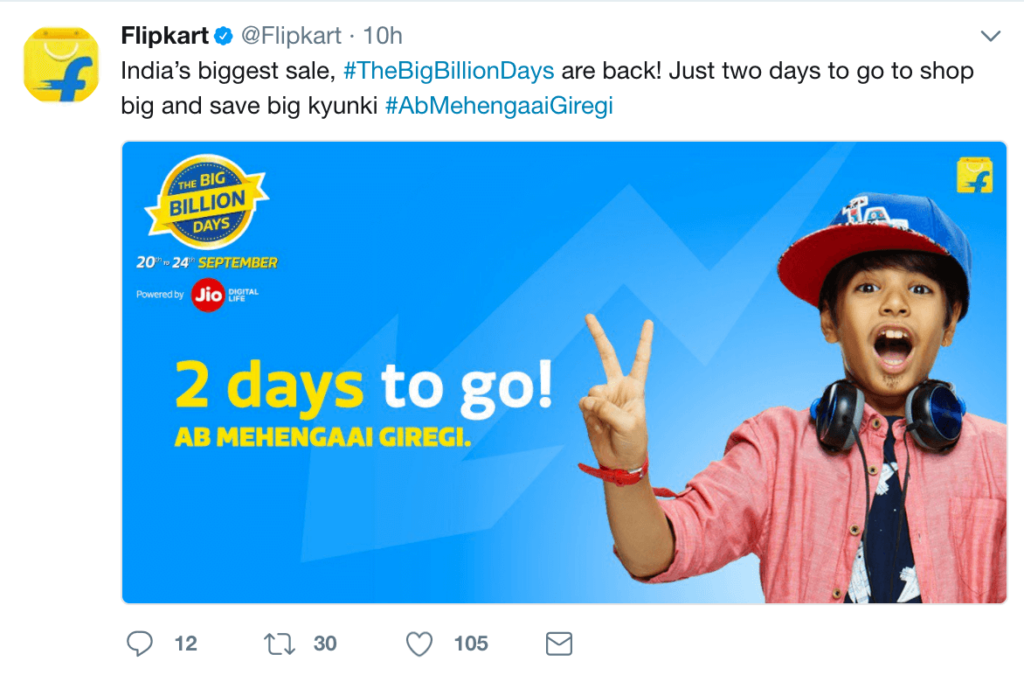
Image Source: Brandsfun
How Businesses Can Apply This Strategy:
- Partner with influencers who align with your brand values and target audience to create authentic promotions.
- Use social media to generate buzz before and during your sales events by running contests, sharing user-generated content, and engaging with followers in real time.
- Leverage micro-influencers who can target niche audiences that align with your brand’s product offerings.
5. Creating a Seamless Omnichannel Experience
Why It Works: Customers today expect a seamless shopping experience, whether they’re shopping online or in-store. Flipkart understands this and has invested heavily in creating an omnichannel experience that integrates its website, mobile app, and offline partners.
How Flipkart Executes This Strategy:
- App-First Approach: Flipkart has adopted an app-first strategy, with many deals and discounts exclusive to app users. This drives mobile traffic and engagement, especially given the growing number of mobile shoppers in India.
- Offline Partners for Delivery: Flipkart partners with offline stores and logistics companies to ensure smooth last-mile delivery, particularly in Tier 2 and Tier 3 cities. This extends their reach and ensures timely deliveries during the sale period.
- Click & Collect: Flipkart has introduced click-and-collect services, where customers can pick up their online orders from designated locations. This is particularly useful for buyers who don’t want to wait for home delivery.
How Businesses Can Apply This Strategy:
- Adopt a mobile-first approach if your audience primarily shops via smartphones.
- Offer a seamless omnichannel experience by integrating online and offline touchpoints, such as in-store pickups or partnerships with delivery services.
- Streamline your website and mobile app user experience to make it easy for customers to find deals, make purchases, and track their orders.
The Role of E-Commerce Analytics and Pricing Intelligence in Big Billion Days Success
E-commerce analytics and pricing intelligence form the backbone of Flipkart’s strategy during Big Billion Days. These tools help Flipkart to accurately forecast demand, optimize inventory, and set dynamic prices that align with consumer expectations while ensuring profitability.
1. Demand Forecasting
Why It Matters: Accurate demand forecasting is essential for handling the massive surge in traffic and orders during Big Billion Days. Flipkart uses historical data, browsing patterns, and search trends to predict which products will be most popular and ensure they have adequate stock.
How Businesses Can Apply This Strategy:
- Use e-commerce analytics to track consumer behavior and forecast demand for different products.
- Adjust your inventory planning and supply chain operations to ensure you can meet the expected demand during peak sales periods.
2. Real-Time Data Analytics
Why It Matters: During the sale, Flipkart collects real-time data on customer behavior, including which products are being viewed, added to carts, and purchased. This allows Flipkart to make data-driven decisions, such as which products to promote more heavily or which discounts to adjust in real-time.
How Businesses Can Apply This Strategy:
- Implement real-time analytics to monitor your customers’ shopping patterns during sales events.
- Use this data to optimize product placement, pricing, and marketing efforts on the go.
3. Optimizing Price Elasticity
Why It Matters: Understanding how price-sensitive your customers are is crucial for setting the right discounts. Flipkart uses price elasticity models to determine how much of a price reduction will drive sales without eroding profitability.
How Businesses Can Apply This Strategy:
- Use pricing intelligence tools to analyze the price sensitivity of your products and set discount levels that maximize sales without compromising margins.
How Flipkart Creates a Loyal Customer Base Through Big Billion Days
Beyond driving sales, Flipkart uses Big Billion Days as an opportunity to build long-term customer loyalty. The strategies they employ focus on creating positive shopping experiences and rewarding customer loyalty.
1. Flipkart Plus Loyalty Program
The Flipkart Plus program offers benefits such as early access to sales, free shipping, and reward points that can be redeemed for future purchases. During Big Billion Days, Flipkart Plus members get exclusive early access to deals, further enhancing the value of the program and encouraging more sign-ups.
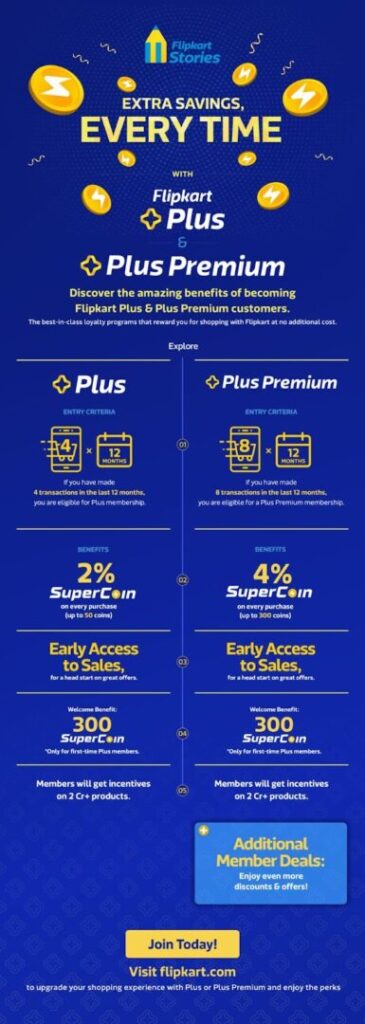
Image Source: Flipkart Stories
2. Customer Service Excellence
Handling millions of transactions over a few days can lead to logistical challenges, but Flipkart prioritizes customer service during Big Billion Days by ramping up its support teams and optimizing its return and refund policies. The goal is to ensure that customers have a smooth experience, even during peak traffic times.
Key Takeaways for E-Commerce Managers and Pricing Managers
The success of Flipkart Big Billion Days provides a comprehensive playbook for businesses looking to create successful e-commerce sales events. The key takeaways are:
- Leverage scarcity and urgency to drive immediate purchases.
- Use pricing intelligence and analytics to set optimal discounts and forecast demand.
- Form strategic partnerships with financial institutions and brands to offer additional incentives.
- Adopt a mobile-first, omnichannel approach to ensure a seamless shopping experience.
- Invest in influencer marketing and social media engagement to reach a wider audience and build social proof.
- Prioritize customer loyalty programs to turn one-time shoppers into repeat buyers.
Conclusion
Flipkart’s Big Billion Days has become a model for how to execute large-scale e-commerce sales events successfully. By creating a sense of urgency, using dynamic pricing, forming strategic partnerships, and leveraging both online and offline channels, Flipkart has set the benchmark for how brands can capitalize on festive promotions and discount events.
For e-commerce managers and pricing managers looking to replicate this success, the key lies in blending technology with customer-centric strategies. By understanding consumer behavior, optimizing pricing strategies, and engaging with customers across multiple channels, businesses can build their own blockbuster sales events and elevate their brand in the crowded e-commerce landscape.
At 42Signals, we provide the e-commerce and pricing insights you need to optimize strategies, enhance sales, and stay ahead of the competition.Contact us today to see how our data-driven solutions can help you create your next big sales event!

